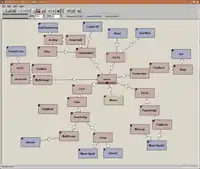Jeskola Buzz
Jeskola Buzz is a freeware modular software music studio environment designed to run on Microsoft Windows using MFC. It is centered on a modular plugin-based machine view and a multiple pattern sequencer tracker.[1]
 Jeskola Buzz - Machine View Jeskola Buzz - Machine View | |
| Developer(s) | Oskari Tammelin |
|---|---|
| Operating system | Microsoft Windows |
| Type | Digital music workstation |
| License | Freeware |
| Website | Jeskola Buzz |
Buzz consists of a plugin architecture that allows the audio to be routed from one plugin to another in many ways, similar to how cables carry an audio signal between physical pieces of hardware. All aspects of signal synthesis and manipulation are handled entirely by the plugin system. Signal synthesis is performed by "generators" such as synthesizers, noise generator functions, samplers, and trackers. The signal can then be manipulated further by "effects" such as distortions, filters, delays, and mastering plugins. Buzz also provides support through adapters to use VST/VSTi, DirectX/DXi, and DirectX Media Objects as generators and effects.
A few new classes of plugins do not fall under the normal generator and effect types. These include peer machines (signal and event automated controllers), recorders, wavetable editors, scripting engines, etc. Buzz signal output also uses a plugin system; the most practical drivers include ASIO, DirectSound, and MME. Buzz supports MIDI both internally and through several enhancements. Some MIDI features are limited or hacked together such as MIDI clock sync.
Development
Buzz was created by Oskari Tammelin who named the software after his demogroup, Jeskola.
In 1997-98 Buzz was a "3rd Generation Tracker" and has since evolved beyond the traditional tracker model.
The development of the core program, buzz.exe, was halted on October 5, 2000, when the developer lost the source code to the program. It was announced in June 2008 that development would begin again, eventually regaining much of the functionality.[2]
Development was restarted in June 2008.[3]
Plugin system
Buzz's plugin system is intended to operate according to a free software model. The header files used to compile new plugins (known as the Buzzlib) contain a small notice that they are only to be used for making freeware plugins and Buzz file music players. The restriction requires that developers who wish to use the Buzz plugin system in their own sequencers pay a fee to the author.[4]
Notable users
Some notable electronic musicians who use Jeskola Buzz include:
- Andrew Sega[5]
- Hunz
- Andreas Tilliander[6]
- James Holden, whose early work was produced entirely within Buzz.[7][8]
- Lackluster
- Oliver Lieb
- The Field[9]
- Crunk Witch
See also
- Buzztrax is an effort to recreate a Buzz-like environment under a free software license which runs under Linux.
- Visual programming language
References
- Future Music magazine, June 2000, p100. http://aijai.net/~apo/buzz/Buzz-FM.jpg Archived 2011-07-23 at the Wayback Machine
- "Archived copy". Archived from the original on 2008-12-04. Retrieved 2008-11-03.CS1 maint: archived copy as title (link)
- http://jeskola.net/buzz/beta/files/changelog.txt
- "Archived copy". Archived from the original on 2009-07-09. Retrieved 2009-04-12.CS1 maint: archived copy as title (link)
- Andrew Sega (2007-04-27). "Taking Tracking Mainstream Part 5" (video). notacon.org. Retrieved 2012-10-21.
- "BUZZ/SAW : Mokira in Miami". 2002-07-18. Archived from the original on 2009-03-26. Retrieved 2011-01-21.
- Napora, Lukasz (2003-08-22). "James Holden Interview". Archived from the original on 2009-04-04. Retrieved 2012-01-21.
- "James Holden". beatfactor.net. Archived from the original on July 23, 2011. Retrieved 2012-05-05.
The stuff everyone is really interested in begins aged 19, with a track called “Horizons”. Written during his summer holidays from his maths degree at Oxford University on a £500 PC and a piece of revolutionary music software called Buzz (a freeware internet download), this crossover anthem of the summer of 1999 propelled young James and his bedroom set-up into the top flight of dance music production.
CS1 maint: unfit URL (link) - Day, David (2007-04-16). "The Field". pitchfork.com. Retrieved 2012-10-21.
External links
- BuzzMachines.com - The central buzz website for the last couple of years, since Oskari's own web site ceased to host Buzz distributions anymore. Several distributions of Buzz which include the core and selected plugins are distributed through this website.
- Jeskola Buzz Latest beta versions of Buzz
- Andrew Sega: Taking Tracking Mainstream Part 1, Part 2, Part 3, Part 4, Part 5 Tracking history with Buzz presentation, Notacon conference, April 27, 2007
